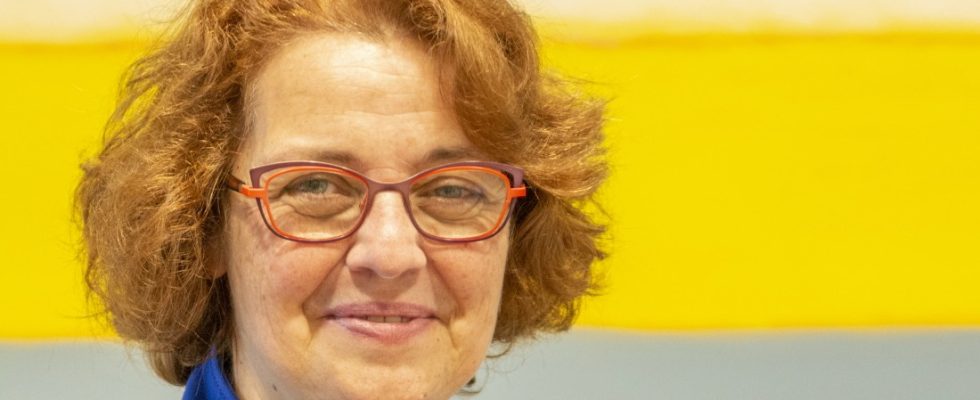Astrid Pellengahr has been to the Glentleiten open-air museum, the Amerang farmhouse museum and the agricultural training center in Landsberg. For the next few days, the center for traditional costumes in Benediktbeuern, a support center in Ingolstadt and the school for wood and design in Garmisch-Partenkirchen are on the agenda. Even though she will still be on the road for a number of weeks before she has visited all the branches in view of the numerous schools and cultural institutions in the district of Upper Bavaria, during her first press interview after two weeks in her new double function as district home nurse and head of the cultural department of the Upper Bavaria district, she already conveys the impression of being well incorporated. She has a lot of details ready, for example she talks very casually about the course for quill embroidery, which is an absolute hit in the Benediktbeur center for traditional costumes.
The merger of offices is an innovation, but no savings, says District President Josef Mederer (CSU). “We want to better combine culture and home and thereby strengthen culture.” This organizational reorientation was made possible because the previous head of culture, Elisabeth Tworek, and the district home nurse, Norbert Göttler, retired almost at the same time. Both had advocated looking at their subject areas from one perspective in the future. For Pellengahr it’s a “great, great task” that she tackles with courage.
Munich is not new territory for the cultural scientist and folklorist. For six years she managed the state office for non-governmental museums in Bavaria, so she knows the Bavarian cultural landscape well and understands the needs of professional and voluntary cultural workers. Before she moved to Munich, she managed the Kaufbeuren City Museum and was head of the cultural department there for two years. In 2020, in the middle of the pandemic, she went to the Württemberg State Museum in Stuttgart, partly because she thought the Bavarian state government’s decision to relocate the state office to Weißenburg as part of the so-called “home strategy” was wrong.
She is happy to return to Munich for a variety of reasons, including family ones. Lots of construction sites are waiting for you here. The culture department of the district has done a lot in recent years under her predecessor Elisabeth Tworek, be it the expansion of the small folk music archive in Bruckmühl into a large center for folk music, literature and popular music or the new forum for homeland and culture in Benediktbeuern, which will serve as a “shop window” for the district’s institutions in the future, or, right next door, the spatial expansion of the center for traditional costumes. All of this is just emerging, which is why the new boss is trying to stabilize herself and is not pursuing any big plans of her own in the short term. “I’m not coming now and driving everyone crazy with the next idea,” says Pellengahr.
The topics of cultural participation in inclusion are very important to her personally
Although the district of Upper Bavaria is based in Munich, it is a rather decentralized system due to its many facilities – in addition to culture, especially schools, support centers and psychiatric clinics. Pellengahr’s trick is therefore to remain in contact with these institutions, to take up their ideas, to use synergies and to initiate new developments. What is important to the district and to her personally is cultural participation and inclusion. “No other municipal body is as close to that as the district,” says Pellengahr, who has already campaigned for it in her previous positions.
Another topic that drives her is digitization. After all, the district sees itself as Upper Bavaria’s cultural memory because of its archives and collections, and this should also be visible online in a database. “It sounds simple, but it’s difficult,” says Pellengahr. Because the software, which is equally suitable for all cultural institutions, first had to be developed. It is currently being tested in the center for traditional costumes.
However, Pellengahr names the dwindling social cohesion as the greatest challenge for her work. This places the culture before the responsible task of strengthening commitment in people’s immediate living environment. “But we have to be careful that the cultural initiatives don’t break away from us.” Mederer also sees a contribution to people’s mental health in their work. You felt that in the times of the pandemic, when culture no longer took place. “We are desolate.”
For Pellengahr himself, home has a lot to do with the self-evident knowledge of norms, values, habits and patterns, i.e. with how we treat one another. The place of birth is not necessarily decisive, she says. She must know. Because she was born in Schleswig-Holstein. “But I have 0.0 percent Schleswig-Holstein in me,” she says. “The environment I am familiar with is Munich and Upper Bavaria.”

